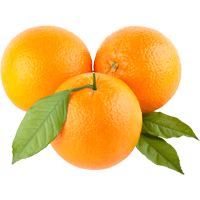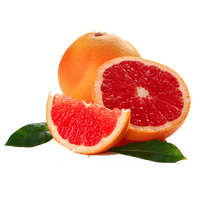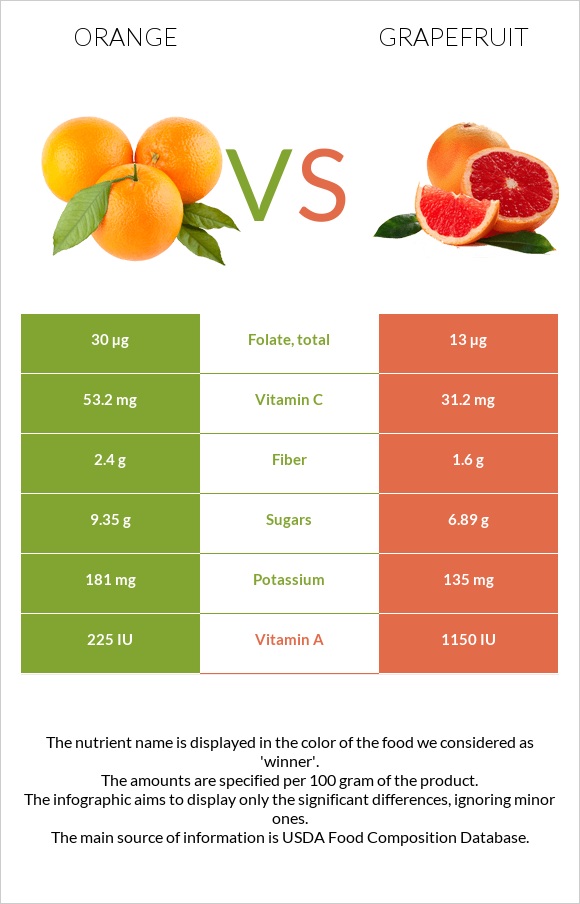Are Grapefruits High In Vitamin C

vs

Summary
Oranges are richer in calories, protein, and carbohydrates, including fiber and sugar, whereas grapefruits contain more fats.
Oranges win in the vitamin category, being richer in vitamin C, vitamin E, vitamins B1, B2, B3, B6, and B9. Grapefruits, however, contain a much higher concentration of vitamin A. When it comes to minerals, oranges contain more iron, calcium, potassium, and copper, while grapefruits are higher in phosphorus.
Both oranges and grapefruits possess certain qualities that can protect against heart disease, diabetes, and cancer and be considered functional foods. However, grapefruits and grapefruit juice must be consumed with caution as they can interfere with certain medications.
Table of contents
- Introduction
- Nutrition
- Vitamins
- Minerals
- Health Impact
- Cardiovascular Health
- Diabetes
- Cancer
- Allergy
- Grapefruit Juice and Medication
- Sources.
Introduction
Oranges and grapefruits are similar in many ways. Both belong to the Rutaceae family and Citrus genus. Here we will discuss how to make the informed choice between the two, based mainly on their nutrition and health impact differences.
Both oranges and grapefruits are hybrids of other citrus fruits. Orange is a hybrid between pomelo and mandarin, whereas grapefruit is a hybrid between pomelo and sweet oranges. Naturally, oranges have been around for much longer, appearing first in Chinese literature in 314 BC (1). Grapefruits, on the other hand, were first described in the year 1750 and were named the "forbidden fruit" of Barbados (2).
The name "grapefruit" allegedly comes from grapefruits growing in clusters on trees, like grapes. Another theory is that grapefruits have often been confused with pomelos; since pomelos are called Citrus maxima, which can be translated as "great fruit," it has wrongly been worded as "grapefruit."
Externally these fruits look quite alike. Grapefruits tend to be larger and weigh more than oranges. The pulp of the most common grapefruits, the ruby red grapefruits, is usually a darker color, more pink than orange.
Nutrition
These fruits have similar macronutrient compositions; however, oranges are slightly higher in protein, carbohydrates, including sugars and fiber, and calories, while grapefruits contain a little more fats. Both fruits naturally do not contain cholesterol.
Oranges, as well as grapefruits, contain some amounts of all the essential amino acids.
One thing these fruits vary in is the glycemic index. Both oranges and grapefruits fall under the classification of low glycemic index foods; however, the glycemic index of oranges can be double that of grapefruits.
A raw orange from Canada has an average glycemic index of 40, while the GI of raw grapefruits from Canada is 25 (3).
Based on Potential Renal Acid Load (PRAL), oranges are a little more alkaline.
Grapefruit is the right choice between these two fruits if you are on a low-carb or a low-calorie diet. But oranges win in a low-fat diet.
Vitamins
Overall, oranges contain more vitamins, being richer in vitamin C, vitamin E, and B1, B2, B3, B6, and B9. However, grapefruits do contain a much higher level of vitamin A.
Both fruits contain a similar amount of vitamin B5 and completely lack vitamin D, vitamin K, and vitamin B12.
Vitamin Comparison
Vitamin comparison score is based on the number of vitamins by which one or the other food is richer. The "coverage" chart below show how much of the daily needs can be covered by 300 grams of the food
![]()
7
:
2
![]()
Contains more Vitamin C +70.5%
Contains more Vitamin E +38.5%
Contains more Vitamin B1 +102.3%
Contains more Vitamin B2 +29%
Contains more Vitamin B3 +38.2%
Contains more Vitamin B6 +13.2%
Contains more Folate +130.8%
Contains more Vitamin A +411.1%
Equal in Vitamin B5 - 0.262
Contains more Vitamin C +70.5%
Contains more Vitamin E +38.5%
Contains more Vitamin B1 +102.3%
Contains more Vitamin B2 +29%
Contains more Vitamin B3 +38.2%
Contains more Vitamin B6 +13.2%
Contains more Folate +130.8%
Contains more Vitamin A +411.1%
Equal in Vitamin B5 - 0.262
Minerals
Oranges are higher in most minerals as well. They contain higher concentrations of iron, calcium, and potassium. Grapefruits, on the other hand, are richer in phosphorus.
Oranges and grapefruits are approximately equal in their amounts of magnesium and zinc.
Both fruits do not contain sodium.
Mineral Comparison
Mineral comparison score is based on the number of minerals by which one or the other food is richer. The "coverage" chart below show how much of the daily needs can be covered by 300 grams of the food
![]()
5
:
1
![]()
Contains more Iron +25%
Contains more Calcium +81.8%
Contains more Potassium +34.1%
Contains more Magnesium +11.1%
Contains more Copper +40.6%
Contains more Phosphorus +28.6%
Equal in Magnesium - 9
Equal in Zinc - 0.07
Contains more Iron +25%
Contains more Calcium +81.8%
Contains more Potassium +34.1%
Contains more Magnesium +11.1%
Contains more Copper +40.6%
Contains more Phosphorus +28.6%
Equal in Magnesium - 9
Equal in Zinc - 0.07
Health Impact
Cardiovascular Health
Several epidemiological studies demonstrate a relationship between the intake of flavonoid-rich foods and the reduction of cardiovascular risk factors and mortality. In particular, flavonoids present in citrus fruits, such as oranges and grapefruit stand out for their high nutraceutical values. Flavonoids can lower the risk of cardiovascular diseases, such as myocardial infarction, dyslipidemia, and coronary artery pathology. The potential explanation may be associated with intracellular pathways involved in direct cardiovascular and cardiometabolic effects mediated by compounds, such as naringenin, hesperetin, and eriodictyol or their glycosylated derivatives. However, the mechanisms of action overall remain unclear (4).
Nevertheless, one study concluded that orange and grapefruit juice, though rich in polyphenols, do not demonstrate the ability to inhibit platelet aggregation, as opposed to the juice of another fruit rich in polyphenols; grape juice (5). Platelet aggregation plays a significant role in atherosclerotic disease development, increasing the risk of cardiovascular-related mortality and morbidity cases.
Another compound that both fruits are naturally rich in is vitamin C. A significant association has been found between high vitamin C intake and protection against cardiovascular mortality and an inverse relationship with markers of inflammation (6).
Diet supplemented with fresh red grapefruit positively influences serum lipid levels of all fractions, especially triglycerides, along with supporting plasma antioxidant activity. The addition of fresh red grapefruit to generally accepted diets could be beneficial for hyperlipidemic, especially hypertriglyceridemic patients with coronary atherosclerosis. Additionally, fresh red grapefruit contains higher levels of bioactive compounds and has significantly higher antioxidant potential than blond grapefruit (7).
Orange juice intake with a high fat and high carbohydrate meal prevented meal-induced oxidative and inflammatory stress, including the increase in endotoxin and toll-like receptor (TLR) expression. This information may help explain the mechanisms underlying postprandial oxidative stress and inflammation, the pathogenesis of insulin resistance and atherosclerosis, and what role orange juice can play in it (8).
The consumption of citrus fruits may also protect against cerebrovascular diseases, such as ischemic stroke and intracerebral hemorrhage (9).
Diabetes
Oranges and grapefruits are both classified as low glycemic index foods. Grapefruits particularly have a low glycemic index of 25. Including fruit, especially high in fiber and water, in diets can play a significant role in people with metabolic syndrome trying to manage weight gain.
One study demonstrated a significantly greater weight loss in the group consuming grapefruit, grapefruit capsules, and grapefruit juice compared with placebo groups. There was also a significant reduction in 2-hour post-glucose insulin level in the grapefruit group compared with placebo. Half of a fresh grapefruit eaten before meals was associated with significant weight loss. In metabolic syndrome patients, the effect was also seen with grapefruit products. Insulin resistance was improved with fresh grapefruit. Although the mechanism of this weight loss is unknown, it would appear reasonable to include grapefruit in a weight reduction diet (10).
One study suggests that grapefruit juice and orange juice play a good role in controlling the glucose levels of experimental animals and can be applied clinically on patients with diabetes and lower cholesterol levels. Diabetic animals treated with orange and grapefruit had a reduced blood glucose concentration compared to the diabetic control animals. The main compound found in citrus fruits responsible for this effect is naringenin and vitamin C, which has been reported to produce glucose and cholesterol-lowering effects due to their strong antioxidant properties. All antioxidants may produce a synergistic effect that may strengthen the B-cells of the pancreas to release more insulin (11).
Both naringenin and vitamin C have been studied for their antidiabetic, antihyperglycemic, and antioxidant effects in streptozotocin-induced diabetes mellitus in rats (12). Naringin and naringenin supplementation has proven to be efficacious for treating metabolic syndrome and obesity in animal models. In metabolic syndrome, obesity, and related cardiovascular complications, naringin influences various regulator and factor mediated fat utilization and preserves mitochondrial function. Moreover, naringin also prevents the TNF-α–mediated inflammatory process and tissue damage in the liver and vasculature (13).
Cancer
There are many studies about the associations between citrus consumption and cancer. Most studies conclude that consumption of citrus fruits protects against cancers of the digestive and upper respiratory tract, demonstrating a significant effect even with moderate citrus consumption. Compounds responsible for these effects are said to be vitamin C and flavonoids. Both, being potent antioxidants, protect against oxidative damage, inhibit the formation of carcinogens and protect DNA from damage. Additionally, flavonoids have antiproliferative and antiangiogenic qualities. The pectin protein found in citrus fruits also expresses anticancer qualities due to its ability to block the carbohydrate-binding of galectin-3, which is necessary for the growth and metastasis of tumor cells and its immunomodulatory potential (14).
An Australian study found that overall, there were 48 studies showing a statistically significant protective effect against cancer of citrus foods, with an additional 21 studies showing a non-significant trend to protection. Forty-one studies showed no effect, and four showed that consumption of citrus fruits significantly increased cancer risk, with another three showing a similar but non-significant trend. The greatest protection for increased citrus consumption appears to be for esophageal, oropharyngeal/laryngeal (mouth, larynx, and pharynx), and stomach cancer. For these cancers, those studies showing a protective effect of citrus fruits showed risk reductions of 40-50% (15).
Allergy
In most cases, if a person is allergic to one citrus fruit, they are advised to avoid all citrus fruits. The allergens found in citrus fruits are not specific to one fruit but to all of them. These include lipid transfer proteins, profilin, and pectin, as well as limonene, that causes contact dermatitis.
The symptoms of a citrus allergy manifest themselves similarly to other food allergies. This can range anywhere from nausea, stomach pains, diarrhea, and oral allergy syndrome, including swelling, itching, burning, or redness of the mouth area to anaphylaxis in rare cases. Citrus fruit can also cause contact dermatitis in people who are allergic to the compound called limonene (16).
Citrus allergies also have cross-reactivity with other common allergens, such as pollen, apples, or peaches (17, 18).
Sensitivity to citric acid is not considered a part of citrus allergy, as the acid does not cause an immune reaction in the organism (19). However, people with citric acid sensitivity can experience adverse effects after consuming citrus fruits.
Grapefruit Juice and Medication
As healthy as grapefruit juice is, it can become a health hazard when combined with certain medications. Grapefruit juice, and sometimes grapefruits, can negatively interact with medications used for high blood pressure, high cholesterol, and depression, such as some calcium channel blockers, statins, immunosuppressants, benzodiazepines, beta-blockers, and other drugs.
A compound called furanocoumarin, which can also be found in Seville (sour) oranges is presumed to be responsible for these effects. In particular, the furanocoumarins bergapten and dihydroxybergamottin have been studied. The mechanism causing this effect is the grapefruit juice's ability to inhibit cytochrome P-450 3A4 isoenzyme and P-glycoprotein transporters in the intestine and liver. The inhibition of cytochrome P-450 3A4 slows down the gut's metabolism, consequently increasing the bioavailability of orally administered drugs by reducing the first-pass effect. P-glycoprotein inhibition also leads to increased levels of the drug in the serum, due to the efflux action of P-glycoprotein (20). Therefore, grapefruit juice boosts the effects of certain medications by increasing bioavailability, which can pose a serious risk to patients taking the drugs. For these patients, it is advised to switch from grapefruit juice to orange juice.
A commonly used drug that grapefruit juice has a boosting effect on is Sildenafil, also known as Viagra. Men who take Viagra have to be cautious of their grapefruit juice consumption as it can lead to symptoms, such as headaches, flushing, and low blood pressure (21).
Sources.
- https://www.nature.com/articles/ng.2472
- https://hort.purdue.edu/newcrop/morton/grapefruit.html
- https://care.diabetesjournals.org/content/diacare/suppl/2008/09/18/dc08-1239.DC1/TableA2_1.pdf
- https://www.ncbi.nlm.nih.gov/pmc/articles/PMC5452232/
- https://academic.oup.com/jn/article/130/1/53/4686066
- https://pubmed.ncbi.nlm.nih.gov/16522902/
- https://www.researchgate.net/publication/7270642
- https://pubmed.ncbi.nlm.nih.gov/20200256/
- Plant foods and the risk of cerebrovascular diseases: a potential protection of fruit consumption
- https://pubmed.ncbi.nlm.nih.gov/16579728/
- https://www.researchgate.net/publication/290511006
- https://onlinelibrary.wiley.com/doi/abs/10.1002/jat.1343
- https://www.ncbi.nlm.nih.gov/pmc/articles/PMC4085189/
- https://www.researchgate.net/publication/286122827
- The Health Benefits of Citrus Fruits
- https://www.nyallergy.com/citrus-allergy
- https://www.ncbi.nlm.nih.gov/pmc/articles/PMC3537725/
- https://www.sciencedirect.com/science/article/abs/pii/S0091674917312642
- https://www.aaaai.org/ask-the-expert/citric-acid-citrus-allergy
- https://www.ncbi.nlm.nih.gov/pmc/articles/PMC2716207/
- https://www.health.harvard.edu/staying-healthy/grapefruit-and-medication-a-cautionary-note

Education: General Medicine at YSU
Last updated: November 29, 2020
Infographic

Vitamin and Mineral Summary Scores
The summary score is calculated by summing up the daily values contained in 300 grams of the product. Obviously the more the food fulfills human daily needs, the more the summary score is.
Vitamin Summary Score
24
![]()
20
![]()
Mineral Summary Score
8
![]()
6
![]()
Macronutrients Comparison
Macronutrient comparison charts compare the amount of protein, total fats, and total carbohydrates in 300 grams of the food. The displayed values show how much of the daily needs can be covered by 300 grams of food.
Protein
6%
![]()
5%
![]()
Carbohydrates
12%
![]()
11%
![]()
Fats
1%
![]()
1%
![]()
Which food is preferable for your diet?
![]()
![]()
is better in case of low diet
 |  | |
| Low Calories diet | | |
| Low Fats diet | | |
| Low Carbs diet | | |
| Low glycemic index diet | |
People also compare
Comparison summary
Which food is richer in minerals?
![]()
Orange is relatively richer in minerals
Which food is lower in Saturated Fat?
![]()
Orange is lower in Saturated Fat (difference - 0.006g)
Which food is richer in vitamins?
![]()
Orange is relatively richer in vitamins
Which food is lower in Sugar?
![]()
Grapefruit is lower in Sugar (difference - 2.46g)
Which food is lower in glycemic index?
![]()
Grapefruit is lower in glycemic index (difference - 20)
Which food is cheaper?
![]()
Grapefruit is cheaper (difference - $0.1)
Which food contains less Cholesterol?
?
The foods are relatively equal in Cholesterol (0 mg)
Which food contains less Sodium?
?
The foods are relatively equal in Sodium (0 mg)
Are Grapefruits High In Vitamin C
Source: https://foodstruct.com/compare/oranges-vs-grapefruit

0 Komentar